Serbian River Flotilla
| River Flotilla | |
|---|---|
 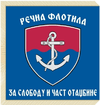 River Flotilla Unit Emblem and Flag | |
| Active | March 30, 1833 – Present |
| Country |
|
| Branch | Serbian Army |
| Type | Brown-water navy |
| Role | Control of inland waterways |
| Size |
Approx 500 pers 16 ships and boats |
| Part of | Serbian Armed Forces |
| Headquarters | Novi Sad at "Aleksandar Berić" barracks |
| Patron | Saint Sava |
| Anniversaries | August 6 |
| Engagements |
First Balkan War Second Balkan War World War I World War II Yugoslav Wars NATO bombing of Yugoslavia |
| Commanders | |
| River Flotilla Commander | Captain (N) Andrija Andrić |
| Insignia | |
| Naval Ensign |
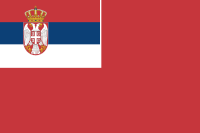 |
The Serbian River Flotilla (Serbian: Речна Флотила / Rečna flotila) is a tactical brigade-level brown water naval branch of the Serbian Armed Forces.
The River Flotilla is headquartered in Novi Sad, with units based in Novi Sad, Belgrade and Šabac.
Subordinate to the Serbian Land Forces since 2006, the River Flotilla is tasked with range of missions within the Republic of Serbia that include environmental policing, counter-terrorism, and border security along 406 kilometers of Serbia's international borders and 1565.9 kilometers of Serbia's waterways.[1]
The flotilla is largely self-sustaining in terms of vessel-specific spares, while relying on the larger Serbian Armed Forces logistics and infrastructure for general support. A reserve structure for the Pontoon Battalions consist of personnel with previous military service in Yugoslavia's pontoon units.[2][3]
The River Flotilla has no rapid deployment capability and although the flotilla does not support international missions, it regularly conducts joint exercises and exchanges with neighbouring riverine forces of Croatia, Hungary, Bulgaria and Romania.[4][5][6][7][8][9]
Deployments, tasks, and operations
Role and deployment
The primary tasks of the River Flotilla are:[10]
- building and maintaining operational capabilities for carrying out tasks of all three missions of the Serbian Armed Forces,
- operationalization and training of command and subordinate units for carrying out dedicated tasks,
- control of inland waterways and provision of maneuvers to the units of the Serbian land forces on and to rivers, channels and lakes, and
- search and rescue on rivers, canals and lakes.
Annually, between 15 June to 1 September, the 1st Pontoon battalion deploys a 362 meters long bridge linking the Zemun quay and Great War Island in a provision of engineering services agreement between the municipality of Zemun and the Serbian Army.[11][12][13][14] In 2017, members of the 1st Pontoon battalion were awarded medallions by the Serbian Ministry of Defence for rescuing an elderly man from a burning boat. The members reportedly swam to the distressed man and pulled him to the river bank where a doctor from the River Flotilla provided first aid.[15][16]
The River Flotilla regularly provides security and technical support to the Memorial Regatta "Zoran Radosavljevic" in the memory of the late pilot and avid yachtsman Major Zoran Radosavljevic, a member of the 127th fighter squadron “Knights” of the Yugoslav Air Force, who died during the NATO bombing of Yugoslavia on 27 March 1999. The Memorial Yacht Regatta “Zoran Radosavljevic” was first held in Montenegro in 1999, and since May 2007 it has been organized in Belgrade, Serbia[17][18]
During the 2014 floods in Serbia, members of the 1st Pontoon Battalion help fight flood in Šabac and Loznica while amphibious vehicles and River Flotilla divers evacuated 2,072 people from Obrenovac[19] Members of the Riverine Flotilla throughout Serbia to combat flooding in Koceljeva, Šabac, Lazarevac, Lajkovac, Lučani and Loznica, mainly in the evacuation of citizens and the reinforcement of bulwarks.[20]
Operational art and tactical doctrine
Doctrine and operating procedures of the flotilla remain the same as those of the former Danube Flotilla of the Royal Yugoslav Navy, dating back to the 1920s.
History
Origin
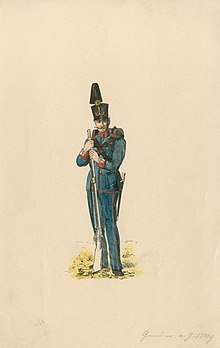
The modern Serbian River Flotilla pulls it origins from Serbian Šajkaši river troops that guarded the Danube and Sava rivers, and especially, the Port of Belgrade, against Ottoman Empire river feets from the 16th to the 19th century. Led by Hungarian or Austrian sponsors against the Ottomans, šajkaš troops were ethnic Serbs, who enjoyed special military status. Their name Šajkaš was derived from the small wooden boat known as chaika (Šajka, tschaiken), a type of galley operated by sail or oars manned by 30 and 50 men, commanded by an officer, a helmsman, an armourer, a drummer, two bowsmen, and up to 36 oarsmen.
The early Serbian Šajkaš fleet achieved its most notable success on 14 July 1456 when an entire Turkish fleet of 200 ships was destroyed under the walls of Belgrade.[21] Later, under Austrian sponsorship Serbian Šajkaši at the Battle of Petrovaradin in 1526 (shortly before the Battle of Mohács) the Šajkaši, commanded by Serbian despot Pavle Bakić, successfully defeating the Ottoman flotilla in the service of Ferdinand I, Archduke of Austria and King of Hungary and Croatia.
After the Ottoman conquest of Hungary in 1541, many Serbian Šajkaši settled in present-day Slovakia and founded the Austrian Tschaikistenflotte. The Serbian Šajkaši became an integral part of the Austrian Danube fleet and after the Austrian conquest of Hungary and present-day Vojvodina, the Šajkaška province in modern-day Serbia was founded.
After the Treaty of Belgrade (1739) the Šajkaši bands in Komarno, Esztergom, Györ and other places were abolished. In 1763 the Habsburg War Council established the Frontier Šajkaši Battalion (Крајишки шајкашки батаљон / Krajiški šajkaški bataljon), known in German as czaikisten-bataillon, in Southeast Bačka and was active in the period of 1763–1873. The Serb colonising community which was employed into the battalion (Šajkaši) was given the šajkaška region, which initially included six villages and eventually increased by eight. The battalion headquarters were in Titel. The battalion had four bands in 1769, with around 1,116 men, although it was constantly expanded.[22]
During the Third Austro-Turkish War (1788-1791) Šajkaši were essential to liberation of Belgrade on October 7, 1789. After the Svištovski Treaty, the Šajkaški Battalion returned to peace regime on September 1, 1791.
During the Serbian Revolution against Ottoman Turkish rule, the national movement of the Serbian population on the Lower Danube and Sava included the Šajkaški Battalion. After the liberation of some parts of Serbia from Turkish rule, the construction of the first Serbian naval vessels for a River Flotilla began and in 1834 the first Serbian brig Srbija was launched during the rule of Prince Miloš Obrenović.[23]
From 1862, the Principality of Serbia possessed a river fleet of 12 steamboats, 52 cargo ships and 14 pontoon bridges all built at the Royal Serbian Shipyard at Čukarica (Serbian: Радионица лађа Краљевине Србиjе / Radionica lađa Kraljevine Srbije).[23]
As political conflicts between Serbians and Hungarians culminated in a sudden attack on Sremski Karlovci on June 12, 1848, the Šajkaški Battalion played a decisive role in helping Serbia become an independent constitutional monarchy and lay the ground for the creation of modern Serbia.[23]
After the declaration of the war against Turkey in 1876, the Principality of Serbia River Flotilla deployed naval mines on the Danube River. This was the first reported use of naval mines in Europe.[23]
The traditional Serbian šajkača hat is derived from the 18th-century Šajkaši in Banat.
World War I (1914-1918)
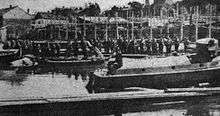
The Kingdom of Serbia received its first true warship, the patrol boat Jadar, on 6 August 1915. Built in Čukarica near Belgrade, the Jadar was armed with two machine guns and was used for mine laying on the Sava and Danube rivers.[24]
At the beginning of the First World War, the flotilla fell under the Velika Ada Ciganlija Command, commanded by Lieutenant Colonel Milan J. Radojević - the first commander of the Serbian River Flotilla. The flotilla maintained the connection between the right bank of the Sava River and Velika Ada Ciganlija island occupied by Serbian troops, protected lines of communication between Belgrade and Obrenovac, assisted in the transport of Serbian troops in Srem, mined waterways and performed reconnaissance.[24]
Kingdom of Yugoslavia (1918-1941)
As an allied victor in 1918, Serbia began the reconstruction and reconstitution of its armed forces, in a new Southern Slav state known as the Kingdom of Serbs, Croats and Slovenes (KSCS) and later as the Kingdom of Yugoslavia. In April 1919 the armed forces of the new South Slav Kingdom were commanded by the new Minister of the Army and Navy.
Within the Naval Department, the Danube Flotilla was headquartered at Novi Sad and commanded over the headquarters, River Flotilla bases, naval detachments on lakes.
As the victors over the now dissolved and defeated Austro-Hungarian empire, the Kingdom expected to receive a significant number of vessels from the former Austro-Hungarian navy and it's Danube Flotilla, now under control by the Allies. In April 1919, the Kingdom requested that six monitors, one river gunboat and a floating workshop to be handed over to the new South Slav navy. On April 1920, the Royal Yugoslav Navy took the final transfer of the four monitors, one river gunboat and three tugs.
The Yugoslav River Fleet command gave the Royal Yugoslav River Flotilla the task of resisting an enemy invasion into Yugoslavia via its internal waterways. Vessels and crews trained in laying river mines and creating obstacles and the new monitors were assigned mine clearing tasks as well as providing support to Yugoslav land units on land. The River Flotilla had at its disposal 202 Austro-Hungarian M-15 floating mines and 202 Austro-Hungarian P-35 river mines stored at Sremska Kamenica.
Royal Yugoslav Navy Danube River Flotilla
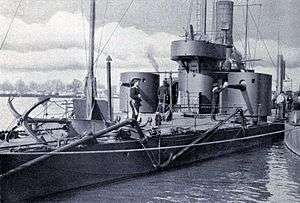
Command Ship
- Cer
River Monitors
All were of around 400-500t with a main armament of two 120mm guns, two or three 66mm guns, 120mm mortars, 40mm AA guns and machine guns.
- Vardar (ex-Bosna, originally Temesh) (1915)
- Drava (ex-Enns) (1915)
- Sava (ex-Bodrog) (1915)
- Morava (ex-Körös) (1915)
River Patrol Boats
- Mostar
- Lovćen
- Velebit
Gun Boats
- Graničar (1929)
- Stražar (1929)
River Tugs
- Cer
- Šabac
- Sisak
In the 1920s, technical re-equipment of the Yugoslav shipyards was carried out and the needs of the Royal Yugoslav river fleet were provided by a new shipyards in Novi Sad and Smederevo, where the Yugoslav monitors were modernized.
In 1940, the Headquarters of the Danube River Flotilla was subordinated to Main Naval Command of the Royal Yugoslav Navy. The fleet included the monitors' group, a number of auxiliary vessels, a proper naval base and a detachment of ships on Lake Ohrid in Macedonia.
Royal Yugoslav Navy River Flotilla Organization (1940)
- River Flotilla
- Command Ship Cer - Novi Sad
- 1st Monitor Group - Dubovac
- 1st Mining-Barrage Group - Bezdan
- 2nd Mining-Barrage Group - Stara Kanjiza and Senta
- 3rd Mining-Barrage Group - Sremski Karlovci
- 4th Mining-Barrage Group - Smederevo
- Đerdap sector command - Tekija and Donji Milanovac
World War II (1941-1945)
Invasion of Yugoslavia
With the German invasion of Yugoslavia in 1941, also known as the April War, the Royal Yugoslav River Flotilla was prepositioned on the Danube and Tisa rivers ready to cooperate with Royal Yugoslav Army land units in order to close off internal waterways to enemy infiltration.
The Royal Yugoslav River Flotilla successfully carried out offensive operations against Axis forces by shelling the German airfield at Mohács, Hungary on the 6 April 1941 and again two days later. On 11 April 1941, units of the flotilla pulled back towards Novi Sad after coming under repeated attacks by German dive-bombers.
Early in the morning of 12 April 1941, a squadron of German Junkers Ju 87 dive-bombers attacked the Yugoslav monitors near Čelarevo. The monitor Drava was hit by several bombs that were unable to penetrate the vessel´s 300mm thick deck armour, until, by chance, one put a bomb straight down the funnel killing it's commander Aleksandar Berić and killing 53 of the 67 man crew. During the attack, Yugoslav anti-aircraft gunners claimed 12 enemy aircraft shot down, not including the Axis aircraft destroyed at Mohács. The remaining three monitors were scuttled by their crews later on 12 April 1941 as German and Hungarian forces occupied their bases and the river systems upon which they operated.[25] The Yugoslav River Flotilla ceased to exist with the occupation of Yugoslavia by Nazi Germany.
Yugoslav Partisan Naval Company
On 11 September 1944, by Order of General staff of Communist-led Yugoslav National Liberation Army (Partisan) in Vojvodina, a Naval Company was formed a part of the Yugoslav 11th Vojvodina NOV brigade in the village of Neštin, Serbia.
The men for the new Naval Company were recruited from the captured German ship Zagreb, a number of signal-corps troops from the General staff of Vojvodina and soldiers from other Partisan units who had earlier served in the navy.
The Zagreb was a passenger ship converted for mine disposal by the German military. It came under Partisan control after the Partisan crew captured it and stripped the vessel of its light arms and 20mm anti-aircraft cannon. This action was led by deputy commander of Zagreb Dragutin Iskra. The Naval Company's first commander was Kara Dimitrijević from Ledinci, deputy commander was Dragutin Iskra, political commissary Svetozar Milovanović, and deputy of political commissary Rada Prodanović. The company had 70 to 80 soldiers and were tasked to attack enemy river traffic on the Danube. The Yugoslav Communist Naval Company operated from the mountains of Fruška Gora at Testera, near Neštin and Krčedin.
On November 20, 1944, the Naval Company was formally based at Novi Sad, Serbia. After little more than two months, the company reported to have severely damaged five enemy vessels and to have lightly damaged forty-three other boats. During the same period, the Partisan Naval Company transported approximately 220,000 Yugoslav Partisans, 2,000 cannons, 3,000 trucks and also other military material across the Danube.
In March 1945, the Naval Company was in the possession of seven patrol boats, nine motor boats and seven assault boats. By mid-April 1945, it was reinforced with five more ships and the command ship Cer. On 20 March 1945, the Sava Flotilla was formed with ships and boats based in Sremska Mitrovica and on 14 April 1945, the Danube Flotilla was formed from ships and boats based at Novi Sad.
Communist Yugoslavia (1945-1991)
Between 1944 and 1965, the Yugoslav River Flotilla was organized in detachments of armored river boats, river assault ships, river auxiliary ships and minesweepers within the Yugoslav Navy (JRM).
During the 1960s, for a short period, the flotilla was subordinated to the Yugoslav National Army's 1st Army, but during later reorganization again became part of the Yugoslav Navy.
Between 1965 and 1984 the River Flotilla underwent significant technical modernization and further doctrinal development of riverine warfare . During the same period the flotilla received a number of new Neštin class minesweepers, a degaussing station and overhauled a number of flotilla craft with new weapons systems.
Yugoslavia & Serbia (1991-present)
With the dissolution of Yugoslavia, on 8 November 1991, RML-308 Botica-class minesweeper, was dispatched to Kopački Rit to intercept the Czechoslovakian towboat Šariš, suspected of smuggling illegal small arms to Croatian separatists at the start of the Yugoslav Civil War. Upon arriving in the vicinity of the mouth of the Drava River on the Danube, the minesweeper was ambushed by separatist Croatian forces using shoulder launched anti-tank rockets and small arms. Yugoslav Navy 1st class Warrant Officers, Kristijan Lampret and Stevan Marković were killed, while RML-308 captain Zoran Marković was wounded by a sniper during the engagement. Although seriously wounded, Marković managed to pilot the stranded boat to shore with the help of several sailors. During the engagement, the RML-308 engaged the Šariš with its 20 mm main gun, damaging its wheelhouse and hitting one its fuel tanks.[26]
With breakup of Socialist Federal Republic of Yugoslavia, the Yugoslav People's Army became the Armed Forces of Serbia and Montenegro in 1992. During this transition the River Flotilla remained as part of Navy. During the 1990s, one new Neštin class river minesweeper was introduced in 1996, and two 601-class landing craft were transferred from sea service at Montenegro to the River Flotilla after being overhauled at "Brodotehnika" shipyard in Belgrade.
Command & organisation
With the reorganisation of the Serbian Armed Forces after the split with Montenegro, the River Flotilla was subordinated to the Serbian Land Forces as the new landlocked Serbian military no longer possessed naval branch.

- Command Company – Novi Sad at "Aleksandar Berić" barracks
- 1st River Detachment – Novi Sad at "Aleksandar Berić" barracks
- 93rd Diving Company - Novi Sad at "Aleksandar Berić" barracks [27]
- 2nd River Detachment – Belgrade
- 1st Pontoon Battalion – Šabac at "Cerski junaci” barracks
- 2nd Pontoon Battalion – Novi Sad at "Aleksandar Berić" barracks
- Logistic Company – Novi Sad at "Aleksandar Berić" barracks
For a number of years the Serbian Armed Forces announced plans for building a winter home base for the River Flotilla at Majurska Ada near Novi Sad. Although successive governments have discussed and announced plans, this base for the Serbian River Flotilla was never realized.[28][29]
Training
The flotilla regularly conducts live-fire and manoeuvre exercises working closely with other Serbian Armed Forces elements and local agencies such as the police, customs, immigration, emergency response and fire service.[30][31]
The flotilla regularly conducts annual combined exercise series with the riverine forces of neighbouring Bulgaria, Hungary, and Romania at various locations on the Danube. The exercises generally involve anti-terrorism and disaster relief scenarios and often include live firing against land and water targets.
Iron Cat Exercise Series
Since 2011, the Serbian River Flotilla and the Hungarian Danube Flotilla, officially known as the 1st Honvéd Explosive Ordnance Disposal and Warship Regiment, have jointly conducted the week-long exercise series dubbed "Iron Cat", alternating locations every year. The aim of the exercise series is to enhance bilateral cooperation and improve the application of tactics, techniques and procedures of both river units while building mutual trust. Both the Serbians and the Hungarians operate the Yugoslav-made Nestin-class river minesweepers.
- "Iron Cat 2018" - held between Budapest and Mohács, Hungary included training in explosive ordnance disposal, river policing, border surveillance and border control, patrol activities, arresting and occupying hostile vessels, escorting and protecting dignitaries and cargo, and river closures. Serbian and Hungarian vessels also conducted live-fire training against air and water targets.[32][33]
- "Iron Cat 2016" - held in Budapest, Hungary included training in protection of cargo ships from attack, securing and blockade of the river.[34][35]
- "Iron Cat 2017" - held near Banoštor, Serbia included training in the blockade and control of inland waterways due to migratory and terrorist threats in the region.[36][37]
- "Iron Cat 2015" - tactical live fire exercise held at the Serbian artillery training ground "Titel" on the Tisa River.[38][39]
- "Iron Cat 2014" - tactical live fire exercise held at the Hungarian Defence Forces Várpalota range in Hungary included joint minesweeping activities.[40]
- "Iron Cat 2013" - tactical live shooting exercise at the Serbian artillery training ground "Titel" on the Tisa River.[41]
- "Iron Cat 2012" - tactical live shooting exercise at the Hungarian Defence Forces Várpalota range included shooting ground-based targets on the using the 20mm PAV-1 and PAV-4 autocannons.[38]
- "Iron Cat 2011" - tactical life fire exercise at the Serbian artillery training ground "Titel" on the Tisa River in Serbia South Bačka District, Serbia.[38][39]
Other recent exercises and operations
- "Otter 2018" - Live Fire Tactical Training (LFTT) exercise “OTTER 2018” held at Taraš near Zrenjanin training Serbian River Flotilla command and units and pontoon battalions in the conduct of river assaults, defending waterways and forced river crossings.[42]
- “Ecka 2017” - anti-terrorist and anti-mining exercise of the 1st River Squadron and 93rd Diving Company at the "Titel" training ground on the Tisa River.[43]
- International Army Games in Russia 2016 - 86 members of 1st and 2nd Pontoon Brigades and 93rd Diving Company and won third place at Russian International Army Games during the "Open water" competition held in Murom, on the Oka River.[44][45]
- "Blue Dolphin 2016" - Live Fire Tactical Training (LFTT) exercise at the Taraš training ground on the Tisa River near Zrenjanin as part of "Morava 2016" command-post exercise.[46][47]
- "Blue Response 2014" - tactical live shooting exercise at the Serbian artillery training ground "Titel" on the Tisa River included artillery and close air support training in support of a forced river crossing.[48]
- Serbia Floods 2014 - Members of the 1st Pontoon Battalion help fight flood in Šabac and Loznica while amphibious vehicles and River Flotilla divers evacuated 2,072 people from Obrenovac[19] Members of the Riverine Flotilla throughout Serbia to combat flooding in Koceljeva, Sabac, Lazarevac, Lajkovac, Lucani and Loznica, mainly in the evacuation of citizens and the reinforcement of bulwarks.[20]
- June 2012 - Members of 1st and 2nd River Flotilla regiment conducted tactical exercises using live artillery firing from the ship's weapons at artillery training area "Titel".[49]
- February 2012 - Members of the First Pontoon Battalion were engaged in clearing snow in Mali Zvornik municipality after heavy snowfalls.[50]
- February 2012 - Professional member of the River Flotilla from Novi Sad, Branislav Jankovic, won the fourteenth swimming competition for St John’s Cross in Ada Ciganlija in Belgrade.[51]
- "Tisa 2012" - three-day trilateral exercise including Serbia, Romania and Hungary held at "Mačvanski Partisan Detachment" training area near Šabac, Serbia included training in assisting civilian populations affected by the floods caused by the outflow of the Sava river.[52]
Personnel
The River Flotilla is an all-volunteer force highly professional and skilled force that has a small number of available spaces for new recruits and tends to accept just a few personnel every year from other Serbian Land Forces elements.
Like the rest of the SAF, the flotilla has generally high morale fuelled by strong patriotism and serving in the flotilla is considered advantageous compared with other SAF branches, due to its relaxed terms and proximity to Novi Sad and Belgrade.
Current ranks
Commissioned officers
The rank insignia for commissioned officers of the Serbian River Flotilla.
| Equivalent NATO code | OF-10 | OF-9 | OF-8 | OF-7 | OF-6 | OF-5 | OF-4 | OF-3 | OF-2 | OF-1 | OF(D) and student officer | |||||||||||||||||||||||||
|---|---|---|---|---|---|---|---|---|---|---|---|---|---|---|---|---|---|---|---|---|---|---|---|---|---|---|---|---|---|---|---|---|---|---|---|---|
(Edit) |
No equivalent |  |
 |
 |
 |
 |
 |
 |
 |
 |
 |
Unknown | ||||||||||||||||||||||||
| Admiral Адмирал |
Vice Admiral Вице Адмирал |
Rear Admiral Контра Адмирал |
Commodore Комодор |
Captain Капетан Бојног Брода |
Fregattenkapitän Капетан Фрегате |
Korvettenkapitän Капетан Корвете |
Fregattenleutnant Поручник Фрегате |
Korvettenleutnant Поручник Корвете |
Unterleutnant Потпоручник | |||||||||||||||||||||||||||
Enlisted
The rank insignia for enlisted personnel of the Serbian River Flotilla.
| Equivalent NATO Code | OR-9 | OR-8 | OR-7 | OR-6 | OR-5 | OR-4 | OR-3 | OR-2 | OR-1 | |||||||||||||||||||||||||||
|---|---|---|---|---|---|---|---|---|---|---|---|---|---|---|---|---|---|---|---|---|---|---|---|---|---|---|---|---|---|---|---|---|---|---|---|---|
(Edit) |
 |
 |
 |
 |
 |
 |
 |
 |
No insignia | |||||||||||||||||||||||||||
| Ensign, 1st class (Заставник I класе) |
Ensign (Заставник) |
Senior Chief Petty Officer (Старији Водник I класе) |
Chief Petty Officer (Старији Водник) |
Petty Officer (Водник) |
Master Seaman (Млађи водник) |
Leading Seaman (Десетар) |
Able Seaman (Разводник) |
Seaman Recruit (Војник) | ||||||||||||||||||||||||||||
Traditions
The Serbian Army observes August 6 as the Day of the River Flotilla to commemorate the launch of the first Serbian warship Jadar in 1915 on the Sava River near Čukarica.[53][54]
Core assets and procurement initiatives
The River Flotilla's core assets mostly date from the 1970s, but have been well maintained and are subject to periodic modest upgrades. Most of the flotilla's vessels are considered to be adequate to the tasks required of them for at least another decade.
Five Nestin-class river minesweepers constitute the core of the River Flotilla. The sturdy, flexible vessels are expected to be in service with the River Flotilla until 2028. Similarly, five Type 22 landing craft and three Type 20 patrol are useful and easily maintained and are expected remain in service for some time. To supplement these vessels, the flotilla has procured a number of small civilian craft, including one Premax 39 multirole fast combat boat built in Serbia by Serbian defence contractor Yugoimport SPDR. Of the flotilla's core vessels, several are routinely out of service for maintenance at any one time, while a single patrol vessel dating from the 1950s, likely RPB-111 Jadar, is laid up awaiting disposal.
In October 2013, a four-year general overhaul and modification of the flotilla's headquarters ship, BPN-30 "Kozara”, was completed at Apatin shipyard with the addition of new diesel-electric propulsion, giving the River Flotilla functional capabilities of a hospital ship and navigation and shipping training ship for Serbian cadets attending the Serbian Military Academy.[55] In July 2017, the "Kozara" sailed from Novi Sad to Hungary in the first international voyage of a Serbian military ship since 1915.[56][57]
In 2017, China donated 24 RIB-720 boats equipped with 150 hp Yamaha outboard motors to Serbia to help with flood relief activities. 10 boats were allocated to the River Flotilla by the Serbian Government.[58][59][60]
Equipment in service
BPN-30 Kozara headquarters ship (PBR) 
- (Serbian: БПН - Брод посебне намене - BPN - Brod posebne namene)
Built for the German Navy in Linz in 1939 the "Kozara" has spent her life on the Danube River. From 1945-46 the ship was used to house American soldiers at the Bavarian city of Regensburg and was sold in 1948, where she was used as a hotel-restaurant until 1953. The vessel was subsequently procured for the Yugoslavian River Flotilla in 1960 and now houses the Serbian River Flotilla staff. She is capable of transporting 250 troops and is armed with 20 mm Oerlikon/Hispano Suiza.
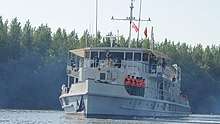
PRB-36 Šabac degaussing vessel (YDG) .svg.png)
- (Serbian: ПРБ - Помоћни речни брод - PRB - Pomoćni rečni brod)
Built at Brodotehnika Shipyard, Belgrade in 1984 under development code RSRB (Rečna stanica za razmagnetisanje brodova) or Vessel Degaussing River Station. Used to degauss river vessels up to a length of 50 m. Capable of transporting 80 troops and is armed with20 mm Oerlikon/Hispano Suiza light calibre anti-aircraft gun and 4 x MTU-4 S Strela 2M (Grail) surface-to-air missile.

Neštin-class river minesweepers (MSR) .svg.png)
- (Serbian: РМЛ - Речни миноловац - RML - Recni minolovac)
Built at Brodotehnika Shipyard, Belgrade under development code S-25 / B-47 and introduced from 1975 to 1979 for the needs of the Yugoslav Navy on the Danube river, it was also sold to Hungary and Iraq. Built specifically for naval mine clearing duties on rivers the class is capable of transporting 100 troops, 24 mines, and is armed with 4 x MTU-4 S Strela 2M (Grail) surface-to-air missile and 20 mm Oerlikon/Hispano Suiza light calibre anti-aircraft gun.

- RML-331 Neštin
- RML-332 Motajica
- RML-335 Vučedol
- RML-336 Đerdap
- RML-341 Novi Sad
Type 22 441-class landing craft (LCU) .svg.png)
- (Serbian: ДБ - Десантни брод - DB - Desantni brod - Formerly ДЈЧ - Десантни јуришни чамац - DJČ - Desantni jurišni čamac)
Built at Greben Vela Luka Shipyard, the class is capable of transporting 80 troops or 6 tonnes of cargo. The last vessel was completed in 1987 and an unknown number is believed to have undergone refit in 2009. The Type 22 is armed with twin 20 mm Oerlikon/Hispano Suiza light calibre anti-aircraft guns and 1 x 30mm grenade launcher.
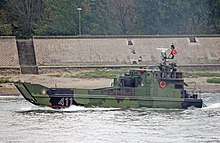
- DB-411 Bečej (ex-DJČ-632)
- DB-412 Belgiš (ex-DJČ-625)
- DB-413 Taraš (ex-DJČ-630)
- DB-414 Begeč (ex-DJČ-631)
- DB-415 Šajkaš (ex-DJČ-631)
Type 20 Biscaya class river patrol craft (PBR) .svg.png)
- (Serbian: РПБ - Речни патролни брод - RPB - Recni patrolni brod)
RPB 111 was built in 1956 for US Navy's Rhine River patrol and later transferred to the Yugoslav Navy. RPC 213 was built at Josip Broz Shipyard, Belgrade and RPB 214 and 216 at Brodotehnika Shipyard, Belgrade, in 1980. The class has a steel hull with fibreglass superstructure. It is capable of carrying 30 troops and is armed with twin 20 mm Oerlikon/Hispano Suiza light calibre anti-aircraft guns.
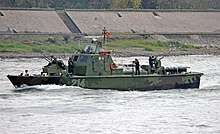
- RPB-111 Jadar
- RPB-213 Kolubara
- RPB-214 Morava
- RPB-216 Timok
River patrol boat (PBR) .svg.png)
- (Serbian: ЧМП - Чамац моторни патролни - ČMP - Čamac motorni patrolni )
Built in 1979 at Greben Vela Luka Shipyard. Transferred from the Serbian border security service to the River Flotilla in 2006. The PBR is armed with .50 cal mounted on the bow.
- ČMP-22
- ČMP-23
- ČMP-24
Other equipment
- RPN-43 tanker ship
.svg.png)
- Premax 39 multirole fast combat boat

- RIB 720 rigid hull inflatable boat

- PTS-M amphibious transport vehicle

- PM M71 mobile pontoon bridge
.svg.png)
Gallery
 RSRB-36 "Šabac"
RSRB-36 "Šabac"- RSRB-36 "Šabac"
- RSRB-36 "Šabac"
 DJČ-412 assault boat
DJČ-412 assault boat DJČ-412 assault boat
DJČ-412 assault boat- RPČ-214 patrol boat
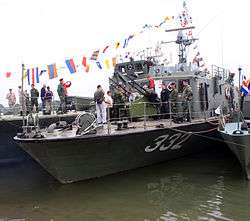
 Small Patrol Boat
Small Patrol Boat- PTS-M of 1st Pontoon Battalion
See also
References
- ↑ Serbian, Armed Forces (30 January 2014). "Rečna flotila na forumu o razvoju vodnog transporta | Vojska Srbije". www.vs.rs. Retrieved 2018-09-14.
- ↑ "Impressive results of the reserve element in training and marksmanship | Ministry of defence Republic of Serbia". Ministry of defence Republic of Serbia. Retrieved 2018-09-14.
- ↑ "Training of Reserve of the Second Pontooneer Battalion of the River Flotilla | Ministry of defence Republic of Serbia". Ministry of defence Republic of Serbia. Retrieved 2018-09-14.
- ↑ Serbian, Armed Forces (14 June 2012). "Završena trilateralna vežba „Tisa 2012" | Vojska Srbije". www.vs.rs. Retrieved 2018-09-14.
- ↑ "Joint exercise of river units of Serbia and Hungary | Ministry of defence Republic of Serbia". Ministry of defence Republic of Serbia. Retrieved 2018-09-14.
- ↑ "Defence Consultations between Serbia and Greece | Ministry of defence Republic of Serbia". Ministry of defence Republic of Serbia. Retrieved 2018-09-14.
- ↑ "Romanian armed forces deputy CHOD visits Serbia | Ministry of defence Republic of Serbia". Ministry of defence Republic of Serbia. Retrieved 2018-09-14.
- ↑ "SAF CHOD visits Croatia | Ministry of defence Republic of Serbia". Ministry of defence Republic of Serbia. Retrieved 2018-09-14.
- ↑ "Joint exercise of the SAF and Hungarian riverine units | Ministry of defence Republic of Serbia". Ministry of defence Republic of Serbia. Retrieved 2018-09-14.
- ↑ Official Website, Serbian Armed Forces. "Rečna flotila | Vojska Srbije". www.vs.rs. Retrieved 2018-09-13.
- ↑ "Pontoon bridge on the Danube dismantled | Ministry of defence Republic of Serbia". Ministry of defence Republic of Serbia. Retrieved 2018-09-14.
- ↑ "Title | Ministry of defence Republic of Serbia". Ministry of defence Republic of Serbia. Retrieved 2018-09-14.
- ↑ "Dismantling the pontoon bridge on Lido | Ministry of defence Republic of Serbia". Ministry of defence Republic of Serbia. Retrieved 2018-09-14.
- ↑ "Pontoon bridge set up on Lido | Ministry of defence Republic of Serbia". Ministry of defence Republic of Serbia. Retrieved 2018-09-14.
- ↑ "Medallions of the Ministry of Defence for the Members Who Excelled in Rescue Missions | Ministry of defence Republic of Serbia". Ministry of defence Republic of Serbia. Retrieved 2018-09-14.
- ↑ "Members of the Serbian Armed Forces in the right place at the right time today again | Ministry of defence Republic of Serbia". Ministry of defence Republic of Serbia. Retrieved 2018-09-14.
- ↑ "15th memorial regatta". Ministry of defence Republic of Serbia. Retrieved 2018-09-14.
- ↑ "Sailing in memory of Zoki | Ministry of defence Republic of Serbia". Ministry of defence Republic of Serbia. Retrieved 2018-09-14.
- 1 2 "Serbian Armed Forces continues to provide assistance | Ministry of defence Republic of Serbia". Ministry of defence Republic of Serbia. Retrieved 2018-09-14.
- 1 2 "Armed Forces helps across Serbia | Ministry of defence Republic of Serbia". Ministry of defence Republic of Serbia. Retrieved 2018-09-14.
- ↑ Official Website, Serbian Armed Forces. "Речна флотила кроз историју | Војска Србије". www.vs.rs. Retrieved 2018-09-13.
- ↑ "Exhibition". Ministry of defence Republic of Serbia. Retrieved 2018-09-14.
- 1 2 3 4 Spasojevic, Dragan (August 2011). "Jubilej recne flotile" (PDF). Odbrana. Retrieved 24 September 2018.
- 1 2 "Prvi komandant srpske rečne flotile i srpske mornarice - Vidovdan Magazin". vidovdan.org (in Serbian). Retrieved 2018-09-13.
- ↑ Shores, et al, 1987, p. 224.
- ↑ Dunaj Ondrejkovics - Sandor de Szlavnicza files (in Slovak)
- ↑ "An exhibition and a technical display on the occasion of the Day of the First Brigade | Ministry of defence Republic of Serbia". Ministry of defence Republic of Serbia. Retrieved 2018-09-14.
- ↑ "159th issue of Odbrana | Ministry of defence Republic of Serbia". Ministry of defence Republic of Serbia. Retrieved 2018-09-14.
- ↑ "Foreign military representatives visited River Flotilla | Ministry of defence Republic of Serbia". Ministry of defence Republic of Serbia. Retrieved 2018-09-14.
- ↑ Serbian, Armed Forces (13 May 2018). "Modernised River Flotilla at the Exercise OTTER 2018 | Serbian Armed Forces". www.vs.rs. Retrieved 2018-09-14.
- ↑ Serbian, Armed Forces (29 June 2012). "Vežba Rečne flotile u gašenju požara „Požar 2012" | Vojska Srbije". www.vs.rs. Retrieved 2018-09-14.
- ↑ "A katonabúvárokat is bevetették az Iron Cat 2018 gyakorlaton" (in Hungarian). Retrieved 2018-09-14.
- ↑ ""Gvozdeni mačak" se "pružio" po Dunavu: Izvedena vežba rečnih jedinica Srbije i Mađarske (FOTO)". www.telegraf.rs (in Serbian). Retrieved 2018-09-14.
- ↑ "Members of the River Flotilla in Iron Cat exercise in Hungary | Ministry of defence Republic of Serbia". Ministry of defence Republic of Serbia. Retrieved 2018-09-14.
- ↑ "Iron Cat 2016" (in Hungarian). Retrieved 2018-09-14.
- ↑ "Sikeresen zárult az Iron Cat 2017" (in Hungarian). Retrieved 2018-09-14.
- ↑ "GVOZDENI MAČAK 2017: Krijumčari i teroristi na vežbi "nisu prošli"". www.novosti.rs (in Serbian). Retrieved 2018-09-14.
- 1 2 3 "Historic Live Fire Exercise". Retrieved 2018-09-14.
- 1 2 "IRON CAT 2015". www.maketarskikutak.com. September 18, 2015. Retrieved 2018-09-14.
- ↑ "The Hungarian Warship Crews Shoot in Serbia". Retrieved 2018-09-14.
- ↑ "Minister Rodic at "Iron Cat" exercise". Ministry of defence Republic of Serbia. Retrieved 2018-09-14.
- ↑ "Modernised River Flotilla at the Exercise Otter 2018 | Ministry of defence Republic of Serbia". Ministry of defence Republic of Serbia. Retrieved 2018-09-14.
- ↑ "Tactical exercise "Ecka 2017" of River Flotilla | Ministry of defence Republic of Serbia". Ministry of defence Republic of Serbia. Retrieved 2018-09-14.
- ↑ "Preparations of the Serbian pontoneers | Ministry of defence Republic of Serbia". Ministry of defence Republic of Serbia. Retrieved 2018-09-14.
- ↑ "International Army Games 2016 closed | Ministry of defence Republic of Serbia". Ministry of defence Republic of Serbia. Retrieved 2018-09-14.
- ↑ "Two-sided tactical exercise". Ministry of defence Republic of Serbia. Retrieved 2018-09-14.
- ↑ "Blue Dolphin 2016 Live Fire Tactical Training | Ministry of defence Republic of Serbia". Ministry of defence Republic of Serbia. Retrieved 2018-09-14.
- ↑ "Висок степен обучености војске | Министарство одбране Републике Србије". Министарство одбране Републике Србије. Retrieved 2018-09-14.
- ↑ "162nd issue of Odbrana brings to you | Ministry of defence Republic of Serbia". Ministry of defence Republic of Serbia. Retrieved 2018-09-14.
- ↑ "SAF clears snow across Serbia | Ministry of defence Republic of Serbia". Ministry of defence Republic of Serbia. Retrieved 2018-09-14.
- ↑ "153rd issue of Odbrana brings to you | Ministry of defence Republic of Serbia". Ministry of defence Republic of Serbia. Retrieved 2018-09-14.
- ↑ "Завршена трилатерална вежба „Тиса 2012" | Министарство одбране Републике Србије". Министарство одбране Републике Србије. Retrieved 2018-09-14.
- ↑ Official Website, Serbian Armed Forces. "River Flotilla | Serbian Armed Forces". www.vs.rs. Retrieved 2018-09-13.
- ↑ Serbian, Armed Forces (6 Aug 2018). "Proslava Dana rečnih jedinica i Dana Rečne flotile | Vojska Srbije". www.vs.rs. Retrieved 2018-09-14.
- ↑ "After the overhaul". Ministry of defence Republic of Serbia. Retrieved 2018-09-14.
- ↑ "First international navigation of Kozara | Ministry of defence Republic of Serbia". Ministry of defence Republic of Serbia. Retrieved 2018-09-14.
- ↑ ""Kozara" back in Serbia | Ministry of defence Republic of Serbia". Ministry of defence Republic of Serbia. Retrieved 2018-09-14.
- ↑ Sputnik. "China Donates Military Equipment to Serbian Army". sputniknews.com. Retrieved 2018-09-14.
- ↑ "Chinese donation to Serbian Armed Forces | Ministry of defence Republic of Serbia". Ministry of defence Republic of Serbia. Retrieved 2018-09-14.
- ↑ "Chinese donation to the Serbian Armed Forces | Ministry of defence Republic of Serbia". Ministry of defence Republic of Serbia. Retrieved 2018-09-14.
External links
| Wikimedia Commons has media related to River Flotilla of the Serbian Armed Forces. |